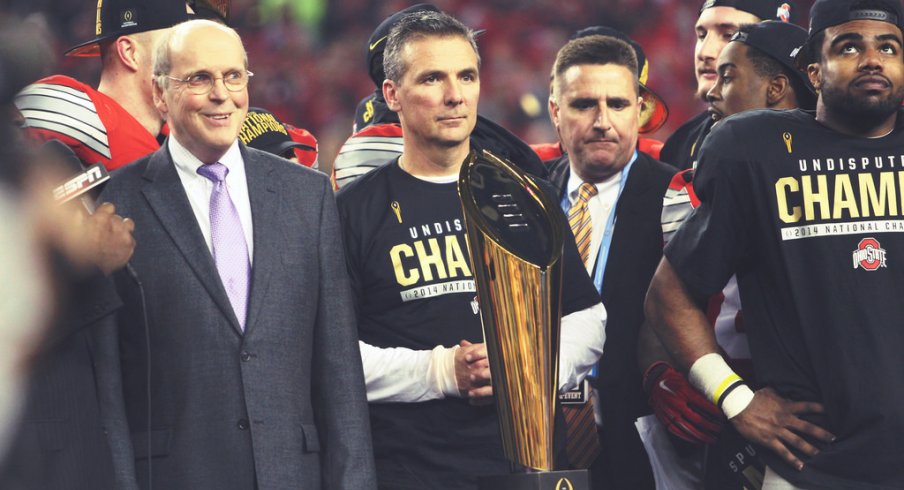Somewhere, Jim Tressel must have been clucking his tongue.
Tresselball is a simple formula for success: make no mistakes, win the field position battle and punish the opponent's errors to win the game. A team plays Tresselball much like grade schoolers play tic-tac-toe to an infinite series of draws.
Jim Tressel knows you find Tresselball boring, and he sympathizes with you. He would just like to know what your coaching philosophy is, and whether that philosophy led you to five national championships or a spot in the College Football Hall of Fame. If not, maybe you should shut your mouth and enjoy #QuietTime.
By the mid-third quarter, Ohio State had gift-wrapped four turnovers for Oregon. First, Cardale Jones botched a mesh point exchange with Ezekiel Elliott in Oregon territory. Next, an Oregon defender dislodged the ball from Corey Smith's arm inside the red zone.
The comedy of errors continued after halftime. A hot pass bounced off Jalin Marshall's hands for an interception on the opening drive of the third quarter. The final turnover was the flukiest play of all: Jones wound up to throw on the run and lost control of the ball while he was cocking his arm.
What team could defeat an opponent as opportunistic and explosive as Oregon with four costly takeaways? By the fourth turnover, with the Buckeyes defending a short field and a 21-17 lead, a Tressel team would have been toast.
Urban Meyer's team overcame the turnovers. Ohio State didn't just survive, it won the game by three touchdowns.
If Meyer teams have a trademark, it is ruthlessness. Ohio State ran a counter play for Ezekiel Elliott over and over again, daring Oregon to stop him. Elliott racked up 246 rushing yards and four touchdowns, the last of which prompted this hissy fit from the Oregon blog of record:
"Urban Meyer can get ****ed for that last touchdown. Yes, Oregon had timeouts left. Were they going to use them? Probably not. Did you kneel once to find out? No. I get it, you wanted to get Cardale Jones a touchdown to troll the world, and I respect the long con, you vicious wizard-man. Your players will love you for that move, as will the recruits you'll continue to get in order to replenish your death-machine. But still, that stung in a way it didn't need to sting, and I'd like to believe that Mark Helfrich has his guys kneel if he's in that situation. So you can go get ****ed."
Aside from one unappreciated act of mercy (electing to punt on 4th and 1 in Duck territory with four minutes left in the game, which ironically led to Ohio State scoring its final touchdown), Ohio State's offense did whatever it wanted to Oregon. The defense played its best game of the season, stifling the Ducks on third downs and forcing more punts than anyone would have expected. Aside from the damnable turnovers, this was Ohio State operating at peak efficiency. No other team does it better.
Meyer's three national championship teams share some similarities. None of Urban Meyer's championship teams has gone undefeated. All three were written off after losing to outmatched opponents near the beginning of the season. Each team was a juggernaut by the end of the season.
It may be premature to compare this 2014 Ohio State team to Tressel's 2002 squad, but I will say this: the 2002 team won the national championship with a bounty of good luck, whereas this year's team did the same thing after losing a Heisman finalist -- twice.
There is no way to reconcile Tresselball with Meyerball; after all, perfect (conservative, error-free play) is the enemy of good (operating at full throttle). If both philosophies are sufficient to lead flawed Ohio State teams to a national championship, imagine what will happen when a future team is both lucky and good.


